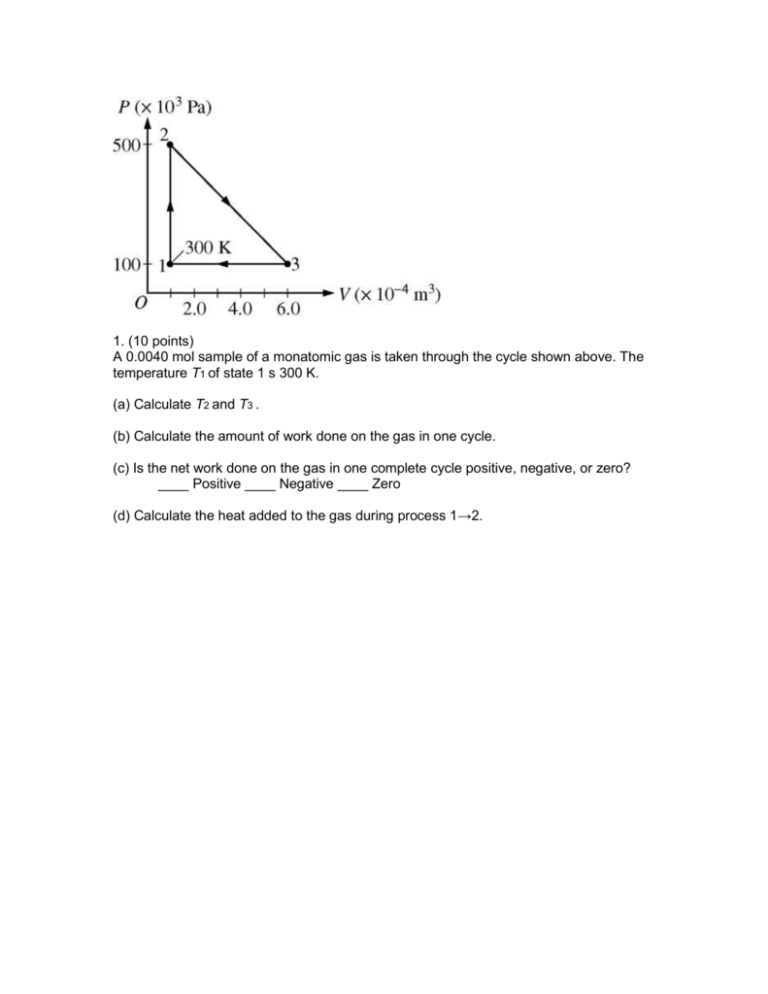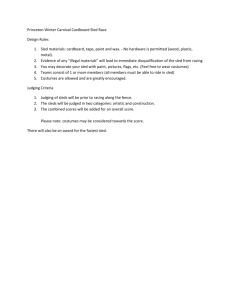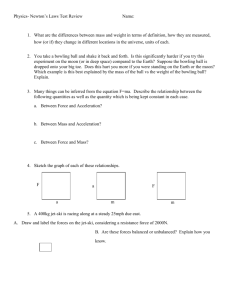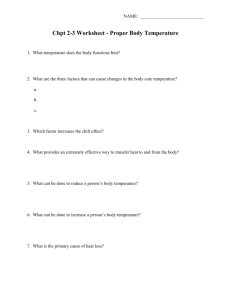1. (10 points) A 0.0040 mol sample of a monatomic gas is taken
advertisement

1. (10 points) A 0.0040 mol sample of a monatomic gas is taken through the cycle shown above. The temperature T1 of state 1 s 300 K. (a) Calculate T2 and T3 . (b) Calculate the amount of work done on the gas in one cycle. (c) Is the net work done on the gas in one complete cycle positive, negative, or zero? ____ Positive ____ Negative ____ Zero (d) Calculate the heat added to the gas during process 1→2. 2. (10 points) Following a nuclear reaction, a nucleus of aluminum is at rest in an excited state 27 Al * , as shown above left. The excited nucleus returns to the ground represented by 13 27 Al by emitting a gamma ray photon of energy 1.02 MeV, as shown above right. state 13 The aluminum nucleus in the ground state has a mass of 4.48 x10-26 kg . Assume nonrelativistic equations apply to the motion of the nucleus. (a) Calculate the wavelength of the emitted photon in meters. (b) Calculate the momentum of the emitted photon in kg m /s . (c) Calculate the speed of the recoiling nucleus in m / s. (d) Calculate the kinetic energy of the recoiling nucleus in joules. 2.4 m/s 25kg 15o 3) (15 points) An empty sled of mass 25kg slides down a muddy hill with a constant speed of 2.4m/s. The slope of the hill is inclined at an angle of 15o with the horizontal as shown in the figure above. a) Calculate the time it takes the sled to go 21m down the slope. b) On the dot below that represents the sled, draw and label a free-body diagram for the sled as it slides down the slope. c) Calculate the frictional force on the sled as it slides down the slope. d) Calculate the coefficient of friction between the sled and the muddy surface of the slope. e) The sled reaches the bottom of the slope and continues on the horizontal ground. Assume the same coefficient of friction. i. In terms of velocity and acceleration, describe the motion of the sled as it travels on the horizontal ground. ii. On the axes below, sketch a graph of speed v versus time t for the sled. Included both the sled’s travel down the slope and across the horizontal ground. Clearly indicate with the symbol tl the time at which the sled leaves the slope. v t Region of Magnetic Field B R x +2e V 4) (10 points) Your research director has assigned you to set up the laboratory’s mass spectrometer so that it will separate strontium ions having a net charge of +2e from a beam of mixed ions. The spectrometer above accelerates a beam of ions from rest through a potential difference V, after which the beam enters a region containing a uniform magnetic field B of constant magnitude and perpendicular to the plane of the path of the ions. The ions leave the spectrometer at a distance x from the entrance point. You can manually change V. Numerical values for this experiment: Strontium atomic number: 38 Strontium ion mass: 1.45 x 10-25 kg Magnitude of B filed: 0.090 T Desired exit distance x: 1.75 m a) In what direction must B point to produce the trajectory of the ions shown? b) The ions travel at constant sped around the semicircular path. Explain why the speed remains constant. c) Calculate the speed of the ions with charge +2e that exit at distance x. d) Calculate the acceleration voltage V needed for the ions with charge +2e to attain the speed you calculated in part (c).










